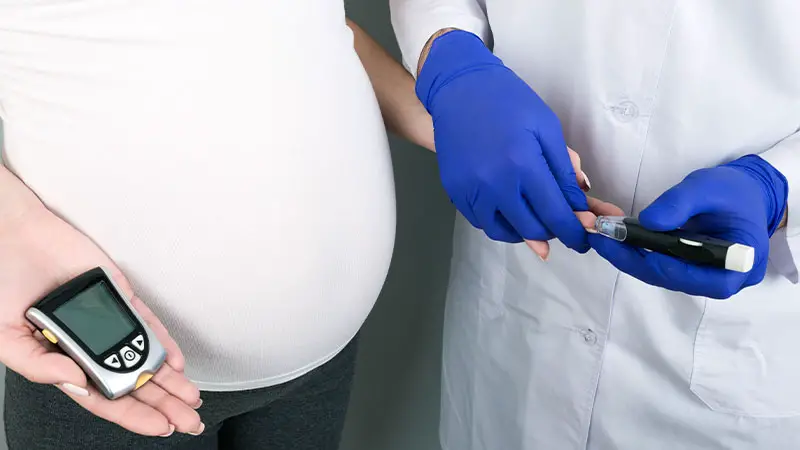What is gestational diabetes, and why is it important to understand during pregnancy? Gestational diabetes mellitus (GDM) is a condition characterized by high blood sugar levels that develop during pregnancy in women who have never had diabetes.
It typically occurs between the 24th and 28th weeks of pregnancy due to the body’s inability to produce enough insulin to meet the increased demands.
Understanding GDM is crucial because it poses risks to both the mother and the baby, including complications such as high birth weight, preterm birth, and an increased likelihood of developing type 2 diabetes later in life.
Recognizing the symptoms, undergoing timely screening, and managing blood sugar levels through lifestyle changes or medication can ensure a healthy pregnancy and minimize potential risks. So, stay focused.

What is Gestational Diabetes?
Gestational diabetes mellitus (GDM) is a condition characterized by high blood sugar levels that develop during pregnancy in women who previously didn’t have diabetes.
It usually occurs around the 24th to 28th week of pregnancy when the body cannot produce enough insulin to meet the increased demands. Insulin, a hormone produced by the pancreas, helps regulate blood sugar levels.
GDM poses risks to both the mother and the baby if left untreated. For the mother, it increases the risk of high blood pressure, preeclampsia, and the need for cesarean delivery.
For the baby, it can lead to excessive birth weight, preterm birth, low blood sugar levels after birth, and an increased risk of developing obesity and type 2 diabetes later in life.
Management typically involves dietary changes, exercise, and sometimes insulin therapy to control blood sugar levels and minimize complications.
Regular monitoring during pregnancy and postpartum follow-up are essential to ensure both the mother and the baby remain healthy.
Causes of Gestational Diabetes
Gestational diabetes mellitus (GDM) is a complex condition influenced by various factors that affect the body’s ability to regulate blood sugar levels during pregnancy.
While the exact cause of GDM isn’t fully understood, several factors contribute to its development. Understanding these factors can help in the prevention and management of this condition.
Hormonal Changes

Pregnancy induces significant hormonal changes in a woman’s body, including increased levels of certain hormones like estrogen, progesterone, and human placental lactogen (HPL).
These hormones play essential roles in fetal development but can also interfere with insulin function. HPL, for instance, reduces insulin sensitivity, making it harder for the body to use insulin effectively, leading to elevated blood sugar levels.
Insulin Resistance

Insulin resistance occurs when the body’s cells become less responsive to insulin’s action, resulting in higher blood sugar levels.
During pregnancy, particularly in the second and third trimesters, women naturally become more resistant to insulin.
This is partly due to the increased production of hormones from the placenta, which can interfere with insulin’s ability to regulate blood sugar.
Genetic Predisposition

Genetics can also play a role in the development of GDM. Women with a family history of diabetes, particularly type 2 diabetes, are at a higher risk of developing gestational diabetes.
Genetic factors can influence how the body produces and uses insulin, making some individuals more susceptible to insulin resistance and impaired glucose tolerance during pregnancy.
Obesity and Excess Weight

Being overweight or obese before pregnancy significantly increases the risk of developing GDM.
Excess adipose tissue, especially around the abdomen, releases inflammatory substances that can disrupt insulin signaling and lead to insulin resistance.
Additionally, women with a higher body mass index (BMI) often have underlying metabolic abnormalities that predispose them to gestational diabetes.
Age

Advanced maternal age is associated with an increased risk of gestational diabetes.
Women over the age of 35 are more likely to develop GDM due to various factors, including decreased insulin sensitivity, changes in body composition, and hormonal fluctuations.
As women age, their pancreatic function may also decline, making it more challenging to maintain adequate insulin production and glucose regulation during pregnancy.
Ethnicity and Race

Certain ethnic groups, such as African Americans, Hispanic/Latino Americans, Native Americans, and Asian Americans, have a higher prevalence of gestational diabetes compared to Caucasian women.
Genetic factors, cultural dietary patterns, and lifestyle habits within these populations may contribute to the increased risk.
For example, diets rich in refined carbohydrates and sedentary lifestyles are common risk factors among ethnic groups with higher rates of GDM.
Previous History of Gestational Diabetes
Women who have had gestational diabetes in a previous pregnancy are at a higher risk of developing it again in subsequent pregnancies.
Additionally, women who have given birth to a baby weighing more than 9 pounds (4,000 grams) or have a history of polycystic ovary syndrome (PCOS) are also at increased risk of developing GDM.
Understanding these underlying causes and risk factors of gestational diabetes is crucial for early detection, prevention, and effective management.
Healthcare providers can offer targeted interventions, including lifestyle modifications, dietary counseling, glucose monitoring, and sometimes insulin therapy, to optimize maternal and fetal outcomes during pregnancy.
Symptoms of Gestational Diabetes
Gestational diabetes mellitus (GDM) is a condition that often presents without noticeable symptoms, which is why routine screening during pregnancy is essential for early detection.
However, some women may experience subtle signs or symptoms that warrant further evaluation.
Understanding these symptoms can prompt timely testing and diagnosis, leading to appropriate management to ensure maternal and fetal health.
Increased Thirst and Urination
One of the hallmark symptoms of gestational diabetes is polyuria (excessive urination) and polydipsia (increased thirst).
High blood sugar levels can cause the kidneys to work harder to filter glucose from the blood, leading to increased urine production.
Consequently, women with GDM may find themselves urinating more frequently, often accompanied by an increased need to drink fluids to quench their thirst.
Fatigue and Weakness
Persistent fatigue and weakness can be indicators of gestational diabetes. Fluctuating blood sugar levels can disrupt energy metabolism, leading to feelings of tiredness and lethargy.
Women with untreated GDM may experience difficulty in maintaining their energy levels throughout the day, despite adequate rest and nutrition.
Blurred Vision
Elevated blood sugar levels can affect the fluid balance within the eye, leading to temporary changes in vision.
Blurred vision or fluctuations in visual acuity may occur in some women with uncontrolled gestational diabetes. This symptom often resolves once blood sugar levels are adequately controlled.
Increased Hunger
Despite consuming regular meals, some women with gestational diabetes may experience persistent hunger or cravings.
This phenomenon, known as polyphagia, occurs due to the body’s inability to effectively utilize glucose for energy.
As a result, individuals may feel hungry shortly after eating, leading to frequent snacking or overeating.
Recurrent Infections
Women with untreated gestational diabetes may be more prone to infections, particularly urinary tract infections (UTIs) and vaginal yeast infections.
Elevated blood sugar levels create a favorable environment for bacterial and fungal overgrowth, increasing the risk of recurrent infections.
Healthcare providers may consider gestational diabetes screening in pregnant women with frequent or unexplained infections.
Nausea and Vomiting
While nausea and vomiting are common symptoms in early pregnancy, persistent or severe symptoms may warrant evaluation for gestational diabetes.
Fluctuations in blood sugar levels can affect gastrointestinal motility and contribute to feelings of nausea and vomiting. Women experiencing persistent gastrointestinal symptoms should discuss their concerns with their healthcare provider.
Unexplained Weight Loss
Although weight gain is expected during pregnancy, unexplained weight loss can be a red flag for gestational diabetes.
Insulin resistance and impaired glucose metabolism can lead to inefficient energy utilization, causing some women to lose weight despite adequate calorie intake. Unexplained weight loss should prompt further evaluation, including screening for GDM.
While these symptoms may raise suspicion for gestational diabetes, it’s important to note that many women with GDM may not experience any noticeable symptoms at all.
Routine screening with glucose tolerance tests during pregnancy remains the gold standard for diagnosing gestational diabetes, allowing for early intervention and appropriate management to optimize maternal and fetal outcomes.
How to Diagnosis Gestational Diabetes?

Diagnosing gestational diabetes mellitus (GDM) is crucial for identifying women at risk of complications and initiating appropriate management strategies to ensure maternal and fetal health.
The diagnostic process typically involves screening tests to assess glucose tolerance levels during pregnancy. Here’s an elaboration on how GDM is diagnosed:
Initial Screening
Most pregnant women undergo an initial screening for gestational diabetes between 24 and 28 weeks of gestation.
It is recommended by major healthcare organizations such as the American Diabetes Association (ADA) and the American College of Obstetricians and Gynecologists (ACOG).
This screening usually involves a glucose challenge test (GCT) or a similar method, where the woman drinks a sugary solution, and her blood sugar levels are measured after a specified period.
Glucose Tolerance Test (GTT)
If the initial screening test suggests elevated blood sugar levels, a follow-up diagnostic test known as the glucose tolerance test (GTT) is conducted.
The GTT involves fasting overnight, followed by the consumption of a larger sugary drink containing a higher concentration of glucose.
Blood samples are then taken at specific intervals over the next few hours to measure how the body processes glucose.
Diagnostic Criteria
The diagnostic criteria for gestational diabetes vary slightly between different healthcare organizations and regions. However, the most widely used criteria are based on the results of the GTT.
Diagnosis is typically made if one or more of the following blood sugar thresholds are met or exceeded: fasting plasma glucose level ≥ 92 mg/dL (5.1 mmol/L), one-hour plasma glucose level ≥ 180 mg/dL (10.0 mmol/L), or two-hour plasma glucose level ≥ 153 mg/dL (8.5 mmol/L).
Alternative Approaches
In some cases, alternative approaches to diagnosing GDM may be considered, particularly for women at higher risk or those with certain clinical indicators.
For example, women with a history of gestational diabetes in a previous pregnancy may undergo early screening in the first trimester.
Additionally, women with risk factors such as obesity, advanced maternal age, or a family history of diabetes may undergo more intensive monitoring or diagnostic testing.
Glycated Hemoglobin (HbA1c) Testing
While not routinely used for GDM diagnosis, glycated hemoglobin (HbA1c) testing may be considered in select cases.
HbA1c provides an estimate of average blood sugar levels over the preceding 2-3 months and can be helpful in identifying women at higher risk of gestational diabetes or pre-existing diabetes.
However, it is not as sensitive or specific as the glucose tolerance test for diagnosing GDM.
Ongoing Monitoring
Once diagnosed with gestational diabetes, ongoing monitoring of blood sugar levels is essential to ensure optimal glycemic control throughout pregnancy.
This typically involves regular self-monitoring of blood glucose levels using a glucometer, as well as periodic follow-up visits with healthcare providers to assess maternal and fetal well-being.
By employing these diagnostic strategies, healthcare providers can accurately identify women with gestational diabetes and implement appropriate interventions to manage blood sugar levels and minimize the risk of complications for both mother and baby.
Wrapping Up
Gestational diabetes mellitus (GDM) is a significant condition that can impact both maternal and fetal health if not properly managed.
Understanding its causes, recognizing symptoms, and undergoing timely screening and diagnosis are crucial steps in mitigating potential complications.
With effective management strategies, including dietary adjustments, regular physical activity, and sometimes medication, most women can maintain healthy blood sugar levels throughout their pregnancy.
Early detection and consistent monitoring play pivotal roles in ensuring a healthy pregnancy and reducing the risk of long-term health issues for both mother and baby.
By staying informed and proactive, expecting mothers can navigate gestational diabetes successfully, fostering positive outcomes and promoting well-being for themselves and their children.
Regular consultations with healthcare providers and adherence to recommended guidelines are essential for managing GDM effectively. Best wishes.
